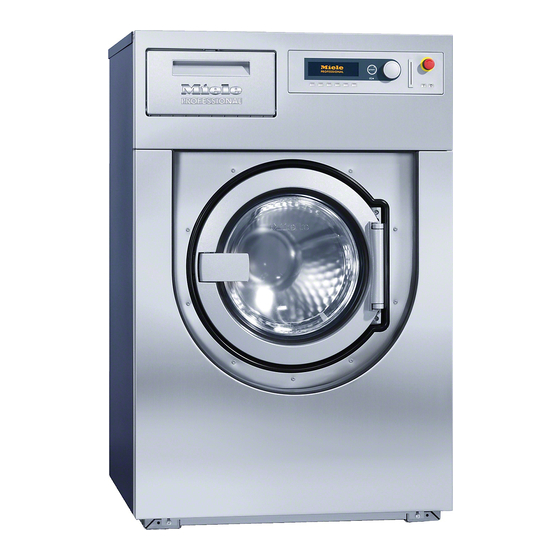Miele PW 6107 Gebruiksaanwijzing - Pagina 6
Blader online of download pdf Gebruiksaanwijzing voor {categorie_naam} Miele PW 6107. Miele PW 6107 40 pagina's.
Ook voor Miele PW 6107: Handmatig (48 pagina's)

Warning and Safety instructions
Further notes
~
Cleaning and disinfecting agents often contain
chlorine-based substances. Do not let such agents
dry out on stainless steel surfaces, as the chlorine
can have a corrosive effect. Use chlorine-free agents
for washing and disinfecting and also for cleaning
stainless steel surfaces to protect them from
corrosion.
If in doubt, confirm with the manufacturer that their
product is suitable. If any agent containing chlorine
comes into contact with the stainless steel surfaces,
wipe it away immediately with clean water. Then dry
with a soft cloth.
~
The manufacturer cannot be held liable for the
effect of a chemical cleaning agent on laundry or the
machine, even when the use of such agents is
recommended.
Please note that changes to the product which have
not been made known by the manufacturer can affect
the quality of the wash result.
Using accessories
~
Accessory parts may only be fitted when
expressly approved by Miele. Using spare parts or
accessories from other manufacturers will invalidate
the warranty, and Miele cannot accept liability.
~
Any additional components used, e.g. suction
devices for liquid agents, electronic water meters or
dispenser monitors, must conform to Safety Class II.
If connected to an external PC, this must conform to
EN 60950-1:2001 (IEC 60950-1:2001).
Chlorine and component damage
Notes on using chlorine bleach and
perchlorethylene
~
Frequent use of chlorine increases the risk of
component damage.
The use of agents containing chlorine, such as
sodium hypochlorite and chlorine bleach in powder
form, can damage the protective upper surface of
stainless steel and cause corrosion to components.
Factors affecting this are chlorine concentration
levels, contact time and temperature. It is therefore
advisable to avoid the use of such agents. Oxygen
based bleaching agents should be used instead.
If, however, chlorine based bleaching agents have to
be used for particular types of soiling, then
anti-chlorine measures must also be carried out. If
this is not done irreparable damage can occur to
components in the machine and to laundry.
6
Anti-chlorine treatment
Anti-chlorine treatment has to be carried out
immediately after chlorine bleach has been used. The
use of hydrogen peroxide or an oxygen based
cleaning or bleaching agent is recommended and the
laundry should not be drained in between.
With thiosulfate, especially when used with hard
water, gypsum can form, which can lead to
incrustations on laundry or deposits in the machine.
The use of hydrogen peroxide is preferable as it aids
the chlorine neutralising process.
The exact quantity of additives and the treatment
temperatures required must be set and tested on site
in accordance with the dosage recommendations of
the detergent and additive manufacturers. The
laundry must also be tested to check whether it
contains any active chlorine residues.
Disposing of your old machine
~
Before disposing of an old machine, first make the
door lock unusable. This way you will prevent
children from accidentally locking themselves in and
endangering their lives.
All personnel working with this machine must be
fully trained in all aspects of its use and safety.
Keep these instructions in a safe and accessible
place.
